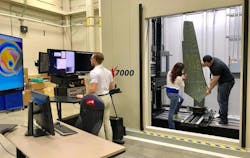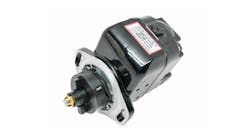NIAR Adds Industrial-Scale Digital X-ray and 3D Computed Tomography Capabilities
The National Institute for Aviation Research (NIAR) at Wichita State University has expanded its capabilities with the addition of several nondestructive inspection (NDI) systems, including an industrial-scale digital X-ray and 3D computed tomography system, or X-ray CT.
The X-ray CT is a multi-source (225/450 kV) and multi-detector comprehensive system used to inspect small and large objects up to five feet without sectioning. This inspection system is used to visualize interior features of solid objects, improving processes such as failure analysis, quality control, troubleshooting manufacturing issues, and the inspection of a variety of articles including additive-manufactured thick metallic structures to fiber fractures in composite laminates.
Computed tomography is a high-fidelity NDI technique that reconstructs 3D images of an object, including the internal surfaces and interior details, from numerous micron-level 2D digital radiographic projections using smart computer algorithms and high-performance computing power. Digital radiographic images are generated by 360° rotation of the object on a motorized stage, which is in between a micro-focus X-ray source and a detector. The real-time evaluation capability of CT with digital radiography increases productivity and eliminates the cost of consumables that are required during traditional X-ray. High-performance multi-threaded computing and novel reconstruction techniques enable production of dynamic volumetric 3D models that include time and motion (4D), which allows real-time inspections of a moving part.
This new capability was made possible through a Defense University Research Instrumentation Program of the Office of Naval Research (ONR). Waruna Seneviratne, technical Director of NIAR Composites Laboratory, was awarded $1.5 million for his proposal titled "X-Ray Computed Tomography for Nondestructively Inspecting Damage Initiation and Growth Mechanics of Composites and Bonded Joints under Fatigue Loading."
Seneviratne was also awarded $2.3 million from ONR for his research proposals titled "Hybrid Test Setup for Investigating Scaling Effects of High-Cycle and Low-Cycle Fatigue Interaction on Fatigue Damage Progression of Composites" and "Material State Monitoring and Autoclave Control System for Validating Models for Detecting Process-Induced Damages in Polymer Composites." These programs will provide valued information to ONR and allowed for the purchase of several high-fidelity inspection systems such as a high-speed multi-channel acoustic emission system for in-situ failure detection and a mobile autonomous scanner (MAUS) for rapid wide-area ultrasonic and eddy-current inspections.





